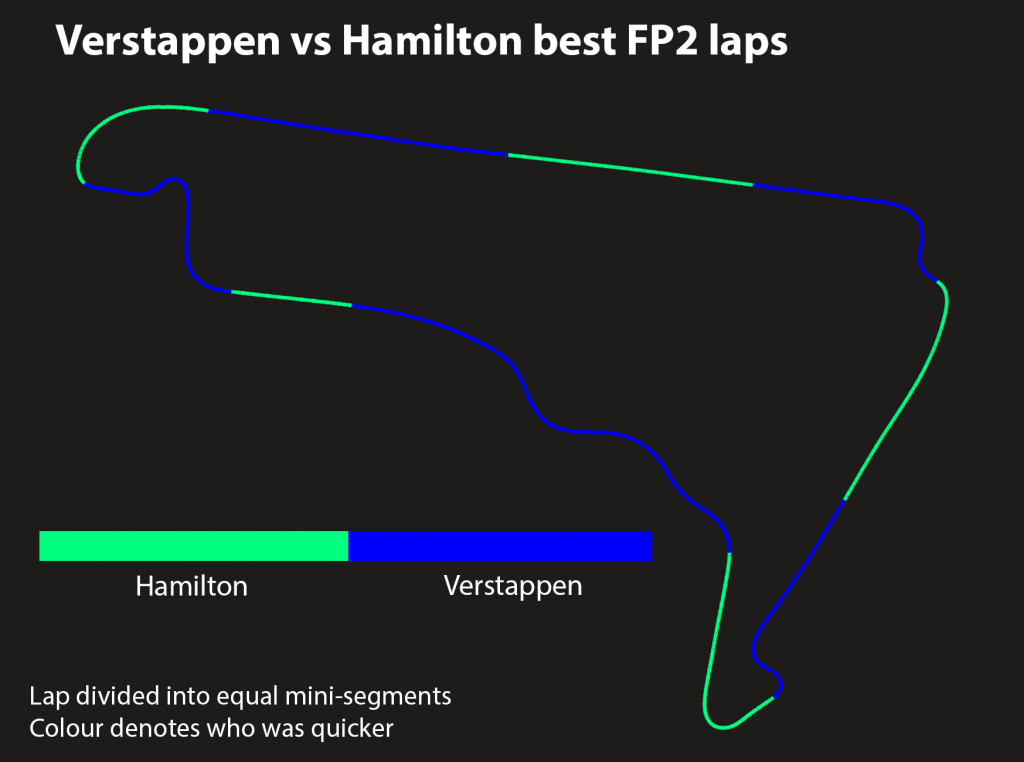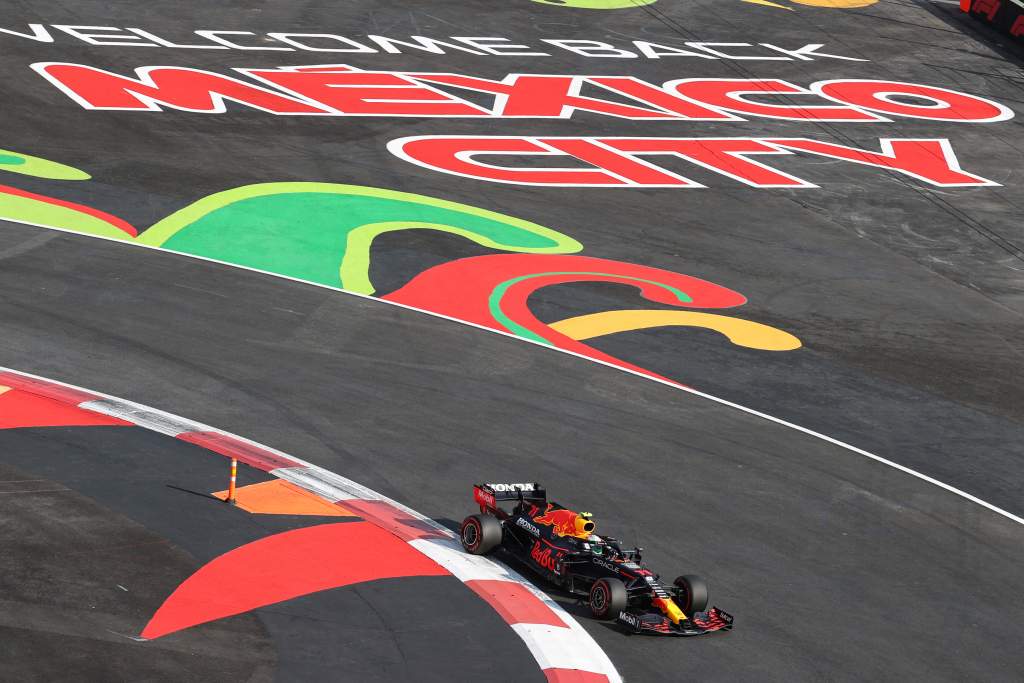Up Next

Friday in Mexico suggests that Red Bull’s pre-event status of hot favourite is fully justified.
Max Verstappen’s fastest time was 0.5s quicker than that of Lewis Hamilton and set at pretty much the same time. Valtteri Bottas slotted between them, but less than a tenth quicker than Hamilton. Sergio Perez’s best lap was within hundredths of Hamilton’s.
Putting their best sectors together changes the picture only slightly, in that it brings Hamilton 0.15s closer to Verstappen but that’s still a chunky 0.35s deficit around a short lap.
It’s not as though the Mercedes was out of its set-up spot, either, both drivers professing themselves happy with its general feel and balance.
“The car’s generally been feeling OK,” said Hamilton. “We’ve been giving it everything we’ve got but they’re just quicker.
“We’re lacking downforce, which is where that 0.5s probably is… they’re definitely too quick for us today.”

Looking at where the Red Bull was faster than Mercedes through the lap is quite illuminating (see above image).
Through the building speed Mansell turn onto the pit straight the Mercedes actually accelerates harder but the Red Bull is quicker almost as soon as the straight begins despite its higher drag.
The Mercedes’ lower drag has it going faster again by around halfway down the straight, before the braking zone begins, at which point the Red Bull is faster and remains so through the Turn 1-2 S-bend sequence.
The Mercedes again accelerates out of there slightly faster, but the Red Bull is going faster by the end of the straight up to Turn 4.
It all suggests the Mercedes has better traction and perhaps a more driveable power curve – and lower drag.
But the fact that the Red Bull can initially overcome the Mercedes’ better entry onto the pit straight despite its higher drag tends to confirm that the Honda does have a power advantage at this altitude.
Where the Red Bull really gets into its stride is through the fast sweeps of the middle sector. Through Turn 9 both Red Bulls are absolutely flat, but both Hamilton and Bottas have to take a lift.
The Mercedes’ lesser drag has it going quicker just before braking for Turn 12 begins, with the Red Bull then quicker through the tight twists of the stadium, where it appeared able to take more kerb thanks to its softer suspension.
Perez – who lost around half the morning session to an early car-damaging off on the initially dusty track – feels there is more to come.

“I am feeling more comfortable on the long runs than over one lap,” he said, “so I think there is still the potential to improve the car on the short runs.
“I have one more session to work on them and my target is to be on that front row tomorrow.
“The margins are going to be very close in qualifying to the Mercedes but hopefully we can lock out that front row.”
Those qualifying simulation laps were set on the soft tyre but comparison between the two cars was less straightforward on the long runs, as the Red Bull’s were made on the medium tyre and Mercedes’ on the soft.
This was on account of both Hamilton and Bottas having flat-spotted a set of hards apiece in the first practice session, and each car is allocated only two sets for the weekend.
The expectation is that it will be a one-stop race and the fast cars will be able to get through Q2 on the mediums, and will then switch to the hards at the stops.
The flat-spotted Mercedes hards were shaved and rebalanced for FP2 but the enforced extensive running on mediums in FP1 meant they needed to be saved in FP2 (the allocation is only three sets of mediums for the weekend and eight sets of softs).
For what it’s worth, those averages were as follows, with Bottas’ position flattered by his short run on the hards with a second stint fuel load:
Long run averages
| 1 | Bottas | 1m21.084s | (H) | 4 laps |
| 2 | Verstappen | 1m21.092s | (M) | 8 laps |
| 3 | Perez | 1m21.553s | (M) | 7 laps |
| 4 | Hamilton | 1m21.742s | (S) | 5 laps |
| 5 | Bottas | 1m21.923s | (S) | 4 laps |
| 6 | Leclerc | 1m22.105s | (M) | 6 laps |
| 7 | Gasly | 1m22.390s | (H) | 4 laps |
| 8 | Sainz | 1m22.485s | (M) | 6 laps |
| 9 | Hamilton | 1m22.580s | (H) | 3 laps |
| 10 | Norris | 1m22.772s | (M) | 6 laps |
But if the comparison to Red Bull does not look promising for Mercedes – much as expected by the team going in because the configuration of its turbo is historically ill-suited to the super-high altitudes here – there is surely some compensation in how far clear of the remainder of the field it appears to be.
In championship terms, being a sure-fire podium contender on a track ill-suited to its car is potentially great damage limitation, much like Verstappen’s second place at Sochi.
Ferrari looks best of the rest but a long way behind Mercedes, though expect the usual Saturday improvement from McLaren (Daniel Ricciardo’s running was limited by a gearbox problem).
Single lap pace
Practice 2 Results
| Pos | Name | Car | Best Time | Gap Leader |
|---|---|---|---|---|
| 1 | Max Verstappen | Red Bull-Honda | 1m17.301s | |
| 2 | Valtteri Bottas | Mercedes | 1m17.725s | +0.424s |
| 3 | Lewis Hamilton | Mercedes | 1m17.81s | +0.509s |
| 4 | Sergio Pérez | Red Bull-Honda | 1m17.871s | +0.57s |
| 5 | Carlos Sainz | Ferrari | 1m18.318s | +1.017s |
| 6 | Pierre Gasly | AlphaTauri-Honda | 1m18.429s | +1.128s |
| 7 | Charles Leclerc | Ferrari | 1m18.605s | +1.304s |
| 8 | Yuki Tsunoda | AlphaTauri-Honda | 1m18.644s | +1.343s |
| 9 | Sebastian Vettel | Aston Martin-Mercedes | 1m18.681s | +1.38s |
| 10 | Fernando Alonso | Alpine-Renault | 1m18.732s | +1.431s |
| 11 | Kimi Räikkönen | Alfa Romeo-Ferrari | 1m18.841s | +1.54s |
| 12 | Lando Norris | McLaren-Mercedes | 1m18.979s | +1.678s |
| 13 | Antonio Giovinazzi | Alfa Romeo-Ferrari | 1m19.227s | +1.926s |
| 14 | Esteban Ocon | Alpine-Renault | 1m19.431s | +2.13s |
| 15 | Daniel Ricciardo | McLaren-Mercedes | 1m19.521s | +2.22s |
| 16 | Mick Schumacher | Haas-Ferrari | 1m19.62s | +2.319s |
| 17 | Lance Stroll | Aston Martin-Mercedes | 1m19.73s | +2.429s |
| 18 | Nicholas Latifi | Williams-Mercedes | 1m20.82s | +3.519s |
| 19 | Nikita Mazepin | Haas-Ferrari | 1m21.581s | +4.28s |






